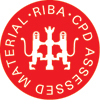Craig White of White Design and ModCell – one of the firms behind the BaleHaus – explains the difference in ethos between traditional straw bale construction and the semi-industrialised panelised technology used by ModCell.
The BaleHaus has been constructed at Bath University by the university's department of Architecture and Civil Engineering. Under the guidance of the BRE Centre for Innovative Construction Materials (also based at Bath University), it is undergoing a string of tests, the results of some of which are surprising.
As well as hearing about the cost of the BaleHaus, its flexibility of design and Modcell's future predictions for the system, we learn how U-values, air tightness and thermal transmittance compare to the PassivHaus standard.
About the contributors
Craig White – White Design, a graduate of the Welsh School of Architecture, Cardiff and the Architectural Association, London, Craig co-founded White Design in 1998. He is also director of ModCell, one of the companies behind the BaleHaus project.
Craig is also a design advice consultant with the Carbon Trust and works with dBERR on the Low Carbon Buildings Programme. He is a senior lecturer at the School of Planning and Architecture at UWE where he teaches Integrated Environmental Design and Construction.
Katharine Beadle – BRE Centre for Innovative Construction Materials, graduated with a degree in architecture from Liverpool University in 2002. After a spell with Chichester District Council developing a new waste and recycling scheme, she completed an MSc in Renewable Energy and Architecture at Nottingham University, followed by a PhD in the Institute of Energy and Sustainable Development at De Montfort University.
Katharine joined the University of Bath in November 2008 as a Research Officer working on the BaleHaus project in the BRE Centre for Innovative Construction Materials with Professor Peter Walker.
Peter Homer – ModCell, heads up the assembly and construction of the Modcell panels, including sourcing the straw, the flying factory and the rendering process.
As well as being a chartered engineer, Peter is a member of both the Institution of Agricultural Engineers and the European Society of Agricultural Engineers.
 Disclaimer: NBS TV programmes are the intellectual property of RIBA Enterprises and it shall be a breach of this right to copy, or in any way exploit commercially or show in public any of the programmes without the express permission of RIBA Enterprises.
Disclaimer: NBS TV programmes are the intellectual property of RIBA Enterprises and it shall be a breach of this right to copy, or in any way exploit commercially or show in public any of the programmes without the express permission of RIBA Enterprises.
